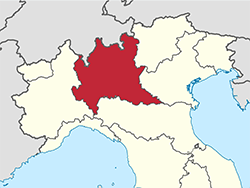| Campione d´Italia | |  |
| A tiny piece of Italy landlocked in Switzerland, in the canton of Ticino, on the shores of Ceresio (Lake Lugano). |
| Ceresio (Lake Lugano) | |  |
| Nestled between Lake Maggiore and Lake Como, Lake Lugano is often called Ceresio by Italy, which shares it with Switzerland. It has a surface area of 48.9 km2, with about one third of it on Italian territory. |
| Como (Lake) | |  |
| About 45 km north of Milan and a few kilometres east of Ticino (Switzerland), Lake Como has been a place frequented by aristocrats since Roman times and is still an outstanding tourist destination today. It is considered one of the most beautiful lakes in the world because of its climate and its landscapes dotted with sumptuous villas and villages. |
| Lago Maggiore | |  |
| Lake Maggiore is a pre-Alpine lake of 212 km2 and 65 km in length, about 50 km northwest of Milan, straddling Piedmont and Lombardy in Italy and the Canton of Ticino in Switzerland. |
| Madonna di Tirano | |  |
| Madonna di Tirano is the area of the city of Tirano where the Basilica of the same name stands, a Catholic church dating from the beginning of the 16th century that should not be missed, whether you are a believer or not. |
| Porto Ceresio | |  |
| The Swiss call it Lake Lugano, but for the Italians it is Ceresio, and at its south-western tip there is a very picturesque village logically named Porto Ceresio, which you should not miss. |
| Tonale Pass | |  |
| On the border between Lombardy and Trentino-Alto Adige, the Tonale Pass connects Val di Sole with Val Camonica at an altitude of 1883 metres. It was once a very important international crossing point. |
| Valtellina | |  |
| The Valtelline, a long valley (some 120 km) in the south of Graubünden, roughly corresponds to the valley of the river Adda, which rises near the Stelvio Pass and flows into Lake Como. |

